High gravity brewing – the pros and cons
- Like
- Digg
- Del
- Tumblr
- VKontakte
- Buffer
- Love This
- Odnoklassniki
- Meneame
- Blogger
- Amazon
- Yahoo Mail
- Gmail
- AOL
- Newsvine
- HackerNews
- Evernote
- MySpace
- Mail.ru
- Viadeo
- Line
- Comments
- Yummly
- SMS
- Viber
- Telegram
- Subscribe
- Skype
- Facebook Messenger
- Kakao
- LiveJournal
- Yammer
- Edgar
- Fintel
- Mix
- Instapaper
- Copy Link
Posted: 7 March 2007 | Graham G Stewart, Professor of Brewing, The International Centre for Brewing and Distilling, Heriot-Watt University, Edinburgh | 1 comment
During the past few decades, process optimisation and increased efficiencies have become priorities for many brewing companies worldwide. High gravity brewing is one method to achieve these objectives.
During the past few decades, process optimisation and increased efficiencies have become priorities for many brewing companies worldwide. High gravity brewing is one method to achieve these objectives.
During the past few decades, process optimisation and increased efficiencies have become priorities for many brewing companies worldwide. High gravity brewing is one method to achieve these objectives.
The manufacturing sector is continuously seeking ways to reduce capital expenditure, their labour force complement, utility and other operational costs whilst, at the same time, ensuring that product quality remains consistently high. The brewing industry is no exception to this trend and one of the procedures employed to achieve these objectives is high gravity brewing. In addition, other brewing initiatives in this area (also known as process intensification) have focussed on:
- Increased rates of fermentation and final attenuation
- High quality yeast viability and vitality
- Decreased production times, including novel yeast strains
- More efficient beer stabilisation and filtration
- Enhanced beer quality and stability
High gravity brewing has been progressively introduced into breweries around the world for the past 40 years or so. It is a procedure that employs wort (unfermented beer) at higher than normal concentrations and, consequently, requires dilution with specially treated water (usually de-oxygenated) at a later stage in process, to the desired gravity or alcoholic strength. By reducing the amount of water employed in the brewhouse, increased production demands can be met without expanding existing brewing, fermentation and storage facilities. Processing less volume of wort and beer, while retaining a constant liquid output, also results in efficiency gains in energy usage, labour, cleaning and effluent costs1. The brewing industry employs a number of unique ways to measure wort concentration. One such measurement is °Plato. It is a measure of the sugar content of a solution derived from its density. The method is based on the per-centage weight of sucrose in a 20°C solution. For example, 12° Plato means that if all of the sugar in that solution were sucrose it would comprise 12% of the total weight of that solution. High gravity brewing began in the USA in the early 1960s. It then spread throughout North America, Australia and South Africa. Taxation and regulation difficulties impeded its implementation in a number of European countries (for example, Germany and the United Kingdom). However, regulation problems have been largely overcome and high gravity brewing can now be implemented worldwide.
Advantages
In addition to the advantages discussed above, high gravity brewing also offers great flexibility in beer type that can be offered for sale. From a single ‘stock’ of high gravity beer a brewer can produce a number of different products with differing original extracts and alcohol levels (for example, light and low/high alcohol beers) without the need to maintain a separate inventory for each beer type. Furthermore, with the advent of hop extracts produced with either carbon dioxide or ethanol as a solvent, malt extracts, syrups and natural colouring materials, the potential range of marketable product types is further expanded2.
Disadvantages
The high gravity brewing process also has a number of disadvantages. Brewhouse material efficiency (the extraction efficiency of soluble material from malt and other cereals employed in the process) is decreased as a result of the more concentrated mash. Also, there is reduced utilisation of hops during the wort kettle boil; the final diluted beer exhibits reduced foam stability and beer flavour variations have also been encountered3. Yeast performance, due largely to the more concentrated wort and the increased ethanol production, can be adversely affected by high gravity worts and, as will be discussed later, this can contribute to a number of aspects of beer stability.
Yeast morphology
Changes in yeast intracellular morphology have been observed, particularly with regard to the yeast cell vacuole. The vacuole is an oval body in the cell that exists as a single organelle, or as several distinct components. It is usually one-third the width of the cell. It acts as a reservoir for the storage of nutrients and specific enzymes and its volume changes with growth phase and environmental conditions. Studies with both ale and lager yeast strains have observed enlargement of the vacuole when cultures are fermenting high gravity wort (20° Plato) when compared to lower gravity wort (12° Plato) (Figures 1 and 2). The enlargement of the vacuole is believed to be a reaction to the osmotic stress imposed on the cells by the high gravity wort.
Dilution water
Reconstitution of the high gravity wort, or fermented wort with water (a process also known as dilution or cutting), can occur at almost any stage during the brewing process. The later the water addition occurs, the greater the increase in brewing capacity. The quality of the dilution water employed is critical and depends on the point of addition. The later in the process it occurs the greater the quality requirement. For example, if dilution occurs towards the end of primary fermentation, the water must be carbon filtered, with the correct pH and be microbiologically sound. However, if dilution occurs as late in the process as possible (at the filtration stage) the greatest care must be taken. The water must be of similar quality and chemical composition as that used for brewing. It must be sterile, have a dissolved oxygen concentration of less than 50ppb, a temperature of 1°C and be carbonated to the CO2 content of the beer. The reason for the low concentration of dissolved oxygen in the dilution water is that packaged beer, unlike most alcoholic beverages, is unstable. One of the major factors contributing to this instability is oxygen2.
Beer stability
Beer stability (or instability) can be considered within six categories: physical (colloidal), flavour, foam, light, biological and gushing. The first three categories have been implicated in beer quality as a result of high gravity brewing procedures. High gravity brewed beers have been shown to be more physically stable compared to their lower gravity brewed counterparts (Table 1). Anecdotal evidence would indicate that high gravity brewed beers also have improved flavour stability. However, beers brewed at higher gravities have poorer head (foam) stability (Table 1 – nibem is a measure of foam collapse rate, the lower the number the poorer the foam stability)4. There are a number of foam-positive compounds in beer. These include polypeptides, iso-alpha acids, melanoidins and metal ions. Polypeptides play an important role in beer foam formation and stability. It has been accepted that the polypeptides of greatest hydrophobic (those that ‘dislike’ water) character produce the most stable foam. It is the property of polypeptide hydrophobicity, rather than size, that is most important in producing stable beer foam. The level of hydrophobic polypeptides can be determined employing chromatographic techniques5 and it has been found that throughout the brewing process there is much greater loss of these polypeptides during a high gravity brewing process compared to lower gravity brewing procedures (Figure 3). When the high gravity beer was diluted to an alcohol concentration equivalent to the low gravity beer, it contained a level of hydrophobic polypeptide less than 50 per cent of the low gravity brewed beer4. It can be seen in Figure 3 that fermentation is a key stage where hydrophobic polypeptides are lost during the brewing process. Two principal factors account for this loss. First, premature foaming (particularly in cylindro-conical vessels) is known to be responsible for the loss of a large amount of foam active substances and this problem is exacerbated during the fermentation of high gravity worts. Second, yeast secretes proteolytic enzymes into fermenting wort and these enzymes have a negative effect on the foam stability of finished beer, through polypeptide hydrolysis during fermentation and storage. This secretion of proteinases is enhanced when stress conditions, such as high gravity wort, are imposed upon yeast cultures (Figure 4)6.
Beer flavour
A further disadvantage of high gravity brewing is that following dilution the beer does not exhibit the same profile of volatile compounds as that found in beer produced using normal gravity worts. After dilution to an equivalent ethanol concentration, the beer produced from high gravity wort often contains elevated levels of esters (Table 2). A number of factors have been shown to influence ester production during wort fermentation. For example, yeast strain and type (ale or lager), temperature and pressure, pitching rate, wort trub levels, dissolved oxygen at the beginning of fermentation, nitrogen, carbon dioxide, fatty acids, amino acid content and certain metal ions are all known to affect the level of esters (and other volatiles) produced during fermentation. In addition, the wort sugars being fermented will influence beer ester profiles. The metabolism of maltose produced considerably lowers the levels of such esters as ethyl acetate and isoamyl acetate than when glucose was fermented. Wort was produced in the Heriot-Watt 2hL pilot brewery. Adjunct worts (high and low gravity) were prepared where syrups (containing high and lower concentrations of maltose) were added directly to the kettle. The relative levels of glucose/fructose and maltose/maltotriose in the worts are shown in Figure 5. Fermentations were conducted and samples removed daily until the test worts had been attenuated. The level of esters produced was substantially lower in the high gravity wort containing enhanced levels of maltose (Figure 6 – only ethyl acetate shown)8. These results illustrate that the use of high maltose syrups affords the brewer the flexibility of operating his/her brewery under high gravity production conditions in order to produce beer with a flavour match to beer produced at lower gravities.
Conclusion
High gravity brewing is not a difficult brewing technique but the yeast must be treated with care since it will be expected to function in a more stressful environment. Although there are negatives (effects on some aspects of beer stability, flavour match, hop utilisation, etc), the positives are more substantial (increased brewing capacity, reduced utility costs, more alcohol per unit of fermentable extract, improved physical and flavour stability).
Acknowledgements
Gratitude is due to the International Centre for Brewing and Distilling, Suntory Limited, Scottish Courage Brewing Limited, Corn Products Corporation and Heineken International for financial assistance in support of various aspects of the research being reported in this paper. 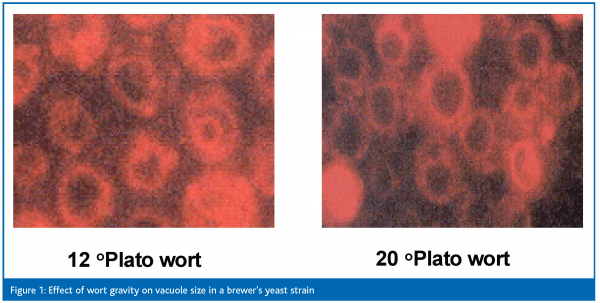

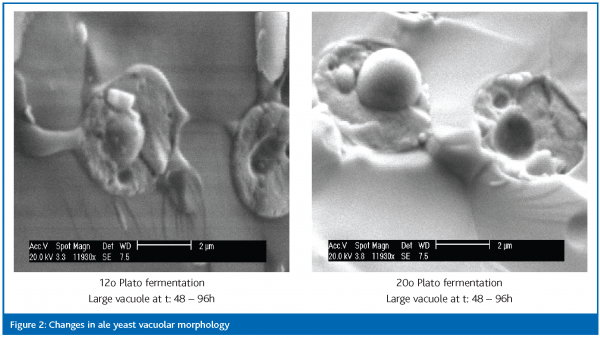

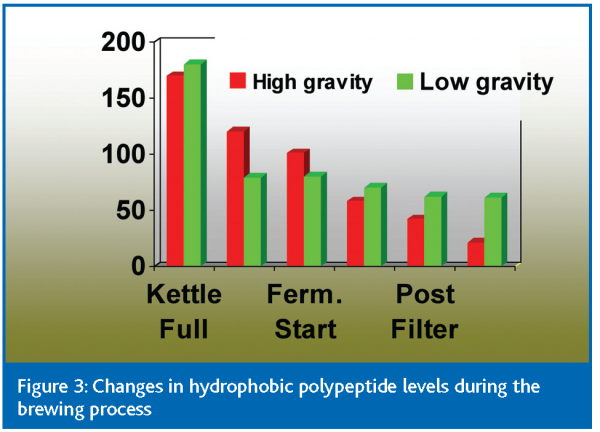

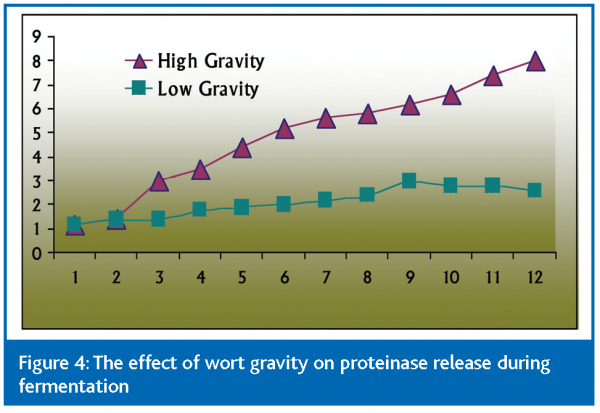

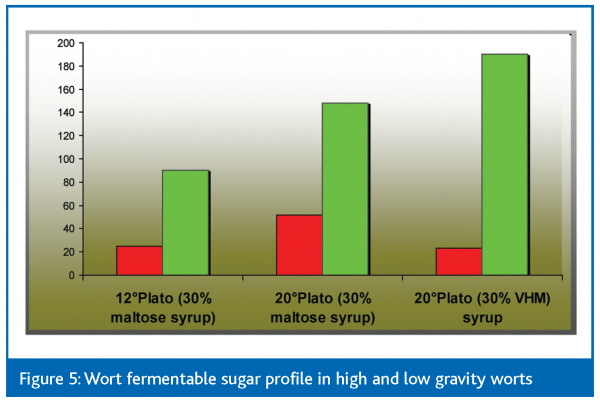

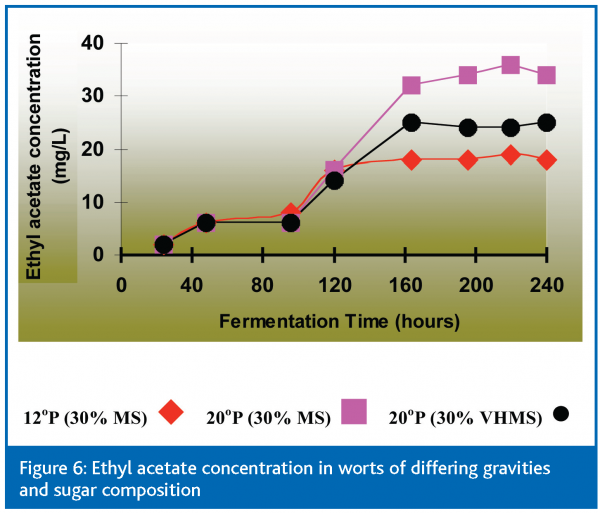

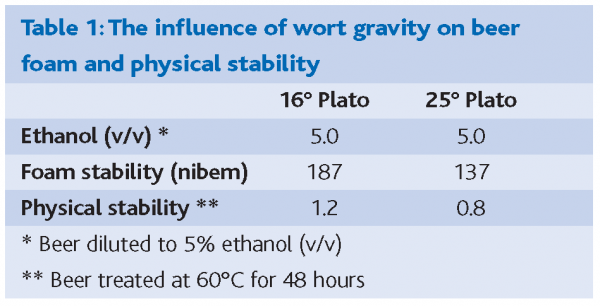

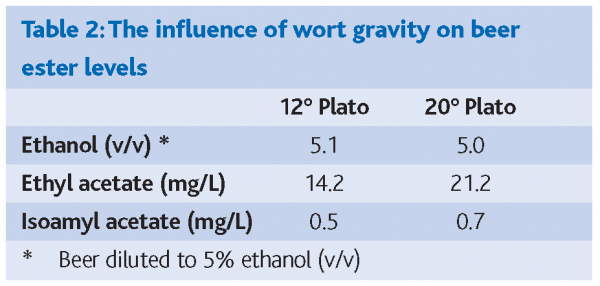

References
- Stewart, G.G. (1999): High gravity brewing. Brewers’ Guardian, 128, 31-37.
- Murray, C.R., Stewart, G.G. (1991): Experiments with high gravity brewing. Birra Malto, 44, 52-64.
- Pratt-Marshall, P.C., Brey, S.E., de Costa, S.D., Bryce, J.H., Stewart, G.G. (2002): High gravity brewing – an inducer of yeast stress. Brewers’ Guardian, 130, 22-26.
- Cooper, D.J., Stewart, G.G., Bryce, J.H. (1998): Some reasons why high gravity brewing has a negative effect on head retention. J. Inst. Brewing, 104, 283-288.
- Bamforth, C.W. (1985): The foaming properties of beer. J. Inst. Brewing, 91, 370-383.
- Brey, S.E., Bryce, J.H., Stewart, G.G. (2002): The loss of hydrophobic polypeptides during fermentation and conditioning of high gravity on low gravity brewed beer. J. Inst. Brewing, 108, 424-433.
- Stewart, G.G., Borthwick, R., Bryce, J.H., Cooper, D., Cunningham, S., Hart, C., Rees, E. (1999): Recent developments in high gravity brewing. Tech. Quart. Master Brewers Assoc. of the Americas, 34, 264-270.
- Younis, O.S., Stewart, G.G. (1999): Effect of malt wort, very-high-gravity malt wort and very-high-gravity adjunct wort on volatile production in Saccharomyces cerevisiae. J. Amer. Soc. of Brewing Chemists, 57, 38-45.





The correct publication year for ref 7 is 1997.